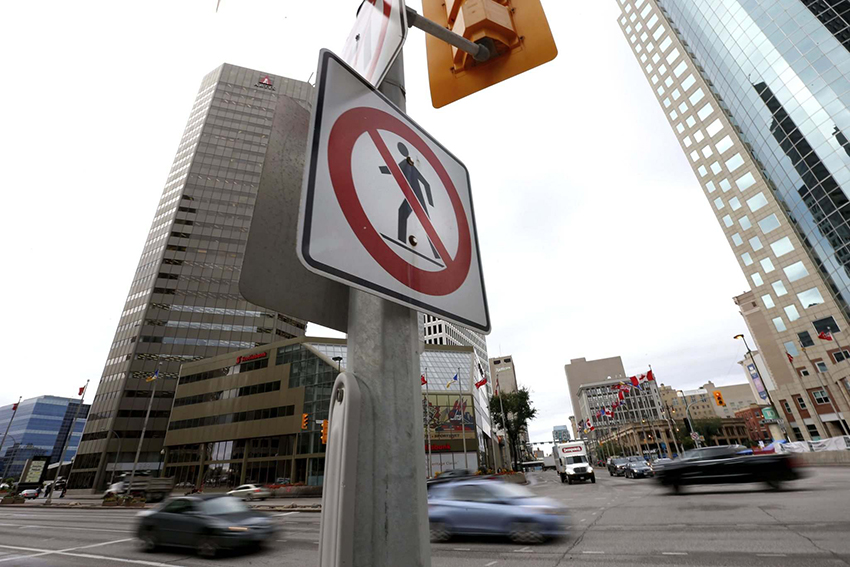
By Brent Bellamy, Creative Director and Architect
Republished with permission courtesy of the Winnipeg Free Press.
Picture the best urban neighbourhood you have ever visited, the most dynamic city centre you’ve been to. Are you surrounded by people on bustling sidewalks, open to busy shops and restaurants? Where is it — maybe Vancouver, Montreal, New York or Paris?

Image: Wayne Glowacki / Winnipeg Free Press File
A focus on pedestrians rather than traffic speed could help make Portage and Main a place to love.
Why do we go on vacation to fall in love with cities with this vibrancy and urban quality, then come home and not demand the same for our own city? Why do we believe a great urban experience can only happen somewhere else?
Winnipeg’s endless Portage and Main debate is a glaring example of this attitude. The value of bringing people back to our central intersection is seemingly only measured by its effect on vehicular traffic. The speed at which we can evacuate downtown in a car is often seen as the only legitimate priority in the debate. Qualitative, and even economic, arguments are brushed aside as meaningless.
Traffic congestion is an important part of the discussion that will need to be resolved. Other intersections, such as Broadway and Main or Portage and Memorial, have a similar range of traffic volumes, and operate without extreme congestion or pedestrian danger. It is important that we not let traffic become the only issue we focus on when making important city-building decisions like this. Elevating the role of pedestrians downtown can be a step towards making Winnipeg one of those vibrant and prosperous cities we fall in love with.
The damaging effects of removing people from the sidewalks at Portage and Main are not an academic urban planning theory. The evidence is real and easy to see.
If Portage and Main was a city, its daytime population would make it the third largest in Manitoba. Despite this density, within a two-block radius, there are numerous empty storefronts, underperforming or vacant buildings and vast surface parking lots. Pushing people underground and behind concrete crash walls that segregate different downtown districts has meant very few amenities are able to survive. Storefrontsreappear away from the intersection, as more people populate the sidewalks.
Having the character of a freeway interchange, the cachet of the city’s once-iconic intersection has diminished. Portage and Main is no longer the place to be; it’s a place to drive through. The area should be the most valuable real estate in the city, but development pressure is so low that it’s instead home to a 38-year-old gravel parking lot. The relocation of some Portage and Main tenants to True North Square is evidence that being connected to a place designed for people and sidewalk life can drive business decisions and growth.
Every property owner at Portage and Main, and almost all in the adjacent area, support reopening the intersection, believing it will be good for business, property values and development pressure on their land. Making the intersection a permanent pedestrian connector is even seen as a way to strengthen the market for the underground mall, struggling to survive as a lunchtime-only service for the towers above.
Downtown Winnipeg is not what it was in 1979, when city council traded pedestrians for an office tower. More people live downtown than ever. A new tallest building is about to rise, making the area home to about 600 people. Residential conversions are happening on south Main Street and along Portage Avenue. Thousands of people will one day live at The Forks. The Exchange District is continuing to grow every year.
We have successfully invested millions of public dollars through tax increment financing, improved streetscaping and small businesses incentives, to support growth of the downtown population. The best way to leverage these investments and elevate the downtown real estate market out of needing further subsidies is to focus on building a neighbourhood that makes urban living and working attractive enough that people will pay a higher market rate for it.
To achieve this, we must begin to make changes that give equal priority to cars and pedestrians, creating active and walkable streets that improve pedestrian connectivity and allow the different downtown areas to grow together, leveraging each other’s success by providing a larger market for services and amenities.
With a construction cost of only $6.1 million — less than four per cent of the annual road-renewal budget, and similar to the reconstruction of three blocks of Empress Street — removing Portage and Main’s pedestrian barricades will begin to invite people back to the city centre, improving the perception of safety and growing the local economy.
No young person has ever said they are moving to Vancouver searching for a shorter commute. No business has ever said they are relocating to Winnipeg because they can drive through downtown quickly. No tourist has ever said they would come back because of the speed of traffic.
Re-establishing Portage and Main as a place for people won’t solve all of downtown’s issues, but it will make an important statement about who we are as a city and who we aspire to be.
We compete with other cities for new business, jobs, investment, immigration and tourism. Many of these places are redefining themselves by making progressive investments to improve their urban quality and pedestrian experience.
Businesses, young people, immigrants and tourists are all looking for a city that is active, safe, and prosperous. They are looking for a place they can fall in love with. Nobody has ever fallen in love with a concrete crash wall.
Brent Bellamy is chairman of CentreVenture’s board and the creative director at Number Ten Architectural Group.
bbellamy@numberten.com